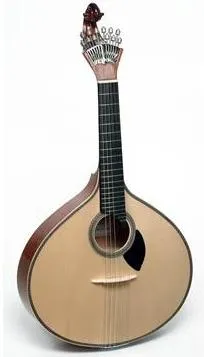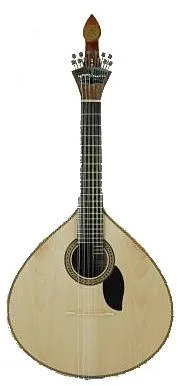|
What is a fado Fado (Portuguese:destiny, fate) music can be traced from the 1820s in Portugal, but probably has earlier origins. In popular belief, fado is a form of music characterized by mournful tunes and lyrics, often about the sea or the life of the poor. However, in reality fado is simply a form of song which can be about anything, but must follow a certain structure. The music is usually linked to the Portuguese word saudade which means to miss or to long for someone or something. Fado only appeared after 1840 in Lisbon, at that time only fado marinheiro (sailor fado) was known and was sung. Nowadays, there are two main varieties of fado, those of the cities of Lisbon and Coimbra. The Lisbon style is the most popular, while Coimbra's is the more refined style. The Portuguese guitar is a plucked string instrument with twelve steel strings, six double courses. It has a distinctive tuning mechanism, the famous 'Preston' tuner (otherwise known as 'watchkey tuner') most notably associated with fado, although it is used in a broader context. Its origin is undoubtedly the 'english guitars' introduced into Portugal during the C18-19.There are two distinct kinds of modern Portuguese guitar models: the Lisboa and the Coimbra. A third kind of Portuguese guitar, the guitol�o, has recently been added to the family. Visually and most distinctively, the Lisboa guitar can be differentiated from the Coimbra guitar for its larger soundboard and scroll ornament above the tuning machine in place of Coimbra's tear-drop shaped motif. The guitol�o, (is a larger version of the Portuguese guitar, and with a wider timbric range, allowing lower and higher pitches. The oldest commonly ( gg, ee, cc, Gg, Ee, Cc. top down) used tuning was the natural tuning. This tuning fell entirely out of favor by the end of the Second World War, however, and is now considered obsolete |
|||
| Lisbon fado guitar | Coimbra fado guitar | ||

|
The Lisboa guitarra (Lisbon) has a scroll type head (which is much like a violin head). It has a string length of 440mm or 458mm which allows it to be tuned in the traditional fado tuning. This instrument is the typical guitarra used to accompany fado singing in Lisboa, and for playing Lisboa style variations. The Lisboa guitar has a narrower neck, smaller string spacing and a slightly shorter scale. The Lisboa guitar has a resonant bell-like sound that the Coimbra guitar lacks. |

|
The Coimbra guitarra has a teardrop or shield type head design. It has a string length of 470mm which allows it to be tuned in the Coimbra style two frets lower, than the Lisboa tuning. This tuning is associated with the music and song of the University of Coimbra. In recent years some Lisboa fado guitarists also have been using this longer scale instrument to accompany fado. Overall, the Coimbra guitar is of simpler construction than the Lisboa guitar. The Coimbra guitar has a more accentuated bass sound. |
|
|
|||
| I have been able to find a supplier for Preston-style tuners in Portugal, so as they are used also for waldzithers, I now have some available for repairs.... 8 string and 12 string. For fado style tailpieces, see the tailpiece page. For new bridges see Fado guitar Bridge page. | |||
|
8 string Preston tuners |
12 string Preston tuners |
||

|

|

|

|
| �60 plus P&P | �80 plus P&P | ||